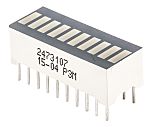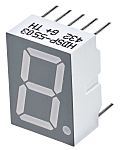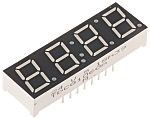
|
What are LED displays?
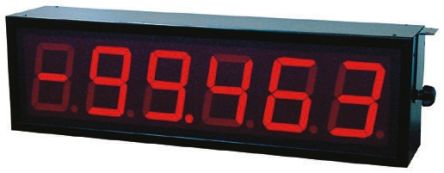
Many readers here will already know that the acronym LED stands for ‘light-emitting diode’, meaning a small cell or conductor that glows and becomes illuminated when a voltage is applied to it.
In entertainment tech sales, the phrase ‘LED display’ is often used very broadly to describe screens on all manner of devices (most commonly for products such as TVs, mobile phones and computer monitors). These high-resolution LED displays tend to use hugely dense diode arrays - often numbering in the thousands - to control illumination and colour cycling across millions of individual pixels, allowing for the rendering of highly detailed images at pixel densities of up to 4k and even beyond.
However, in engineering component terms, the definition of an ‘LED display’ is more commonly taken to be a discrete light-up readout board - often relatively small and simple - that’s designed to be attached to an instrument panel or mounted on a printed circuit board (PCB). The purpose of these types of LED displays is typically just to provide clear and concise information readout for the user.
Such LED displays are often designed around the classic ‘segmented number’ format, which will be familiar to anyone who’s ever owned a basic digital watch. Other more advanced models may use a range of alternative display styles and diode configurations, including popular versions sold with either dot matrix or light bar arrays.
In this guide, we’ll learn more about the various LED display types that are widely available to buy today from suppliers worldwide. We’ll also look at which types of displays might be best suited to what sorts of applications, and how to ensure a good balance of functionality and value for money when planning an LED display purchase for your next project.
Types of LED displays
There are numerous LED display panel types available on today’s market - as noted in the opening section of this guide, some of the more common configurations include segmented displays, dot matrix, alphanumeric and light bar versions.
In this section we’ll look a little more closely at what the differences between these types of LED screens are, and when a particular model or style might prove more useful/economical than another.
7-Segment LED displays
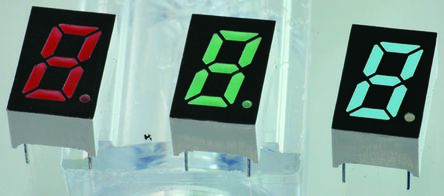 A 7-segment LED display is one in which any numeral can be laid out using an arrangement of seven separate LED segments. The individual diodes in a 7-segment display are arranged in a rough figure-eight shape, such that each LED segment can be individually illuminated (or left unlit), allowing the grouping to display any digit from 0-9.
A 7-segment LED display is one in which any numeral can be laid out using an arrangement of seven separate LED segments. The individual diodes in a 7-segment display are arranged in a rough figure-eight shape, such that each LED segment can be individually illuminated (or left unlit), allowing the grouping to display any digit from 0-9.
Seven-segment display arrangements are sometimes abbreviated to SSDs (not to be confused with the same acronym used for solid state drives!), and can also be referred to as ‘seven-segment indicators’. They’re among the most common LED display configurations used for providing simple numerical readouts on a broad range of device types, including but not limited to:
- basic calculators
- many types of digital clocks and timers
- programmable price displays and numerical information boards
- a variety of electronic meters
On the whole, seven-segment displays are generally limited to showing numerals. They’re not considered especially suitable for lettering, as the minimal number of segments in each LED display makes it difficult to render sufficiently readable characters.
14-Segment LED displays
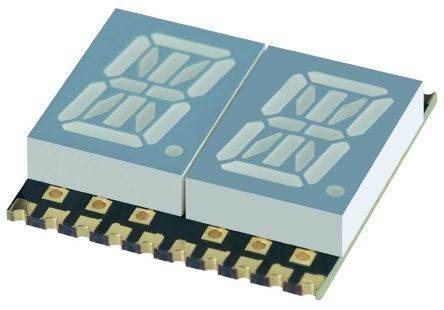 A 14-segment led display takes much the same basic format as the 7-segment version described above, but uses double the number of diodes - this time arranged in the familiar figure-eight shape, but with the addition of diagonal diodes crossing through the centre point. (This configuration is thus sometimes known as a Union Jack or starburst LED display.)
A 14-segment led display takes much the same basic format as the 7-segment version described above, but uses double the number of diodes - this time arranged in the familiar figure-eight shape, but with the addition of diagonal diodes crossing through the centre point. (This configuration is thus sometimes known as a Union Jack or starburst LED display.)
The increased LED count allows for a significantly more detailed display, meaning that full alphanumeric readouts become much more feasible. However, even with fourteen segment displays, some letters in the alphabet remain difficult to render with great clarity, and so the potential for ambiguity still exists to a degree.
In the mid-1980s, pinball machines and other arcade games were among the first everyday devices to help popularise the LED 14-segment display, and in some design applications, the format is still used to achieve a very stylised ‘retro’ aesthetic. In more practical scenarios, 14-segment displays remain a popular option for many device types, including:
- DVD players
- car stereo fascias
- microwave ovens
- caller ID phone screens
16-Segment LED displays
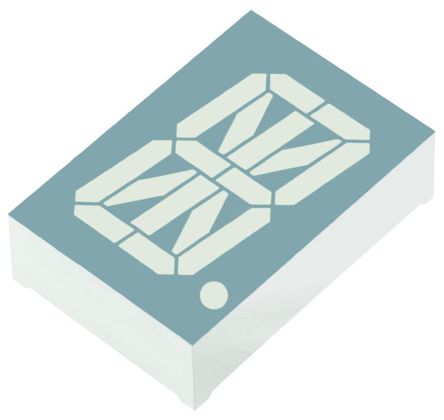 As with the 7-segment and 14-segment displays outlined previously, a 16-segment LED display also conforms to the same basic figure-eight arrangement but adds in a pair of additional diodes by splitting both the upper and lower horizontal segments into two.
As with the 7-segment and 14-segment displays outlined previously, a 16-segment LED display also conforms to the same basic figure-eight arrangement but adds in a pair of additional diodes by splitting both the upper and lower horizontal segments into two.
This allows for yet more detail in the graphical rendering of numbers and letters and is generally deemed sufficient for reasonably full alphanumeric LED display readouts on
devices where a more intricate dot matrix LED display is impractical or overkill.
Again, typical examples might include:
- DVD players, speakers and car stereos
- ovens, microwaves and coffee makers
- digital scales, shavers and other kitchen/bathroom gadgets
- alarm clocks and digital timers
- arcade games and slot machines
- telephone caller ID panels
- public information displays and scoreboards
Dot matrix LED displays
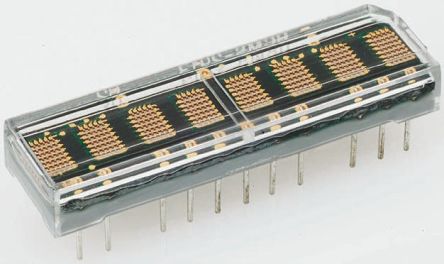 LED dot matrix displays can be thought of as the next logical step up from 16-segment alphanumeric arrangements. In a typical dot matrix LED display, the clustering of individual diodes is denser still, while the ‘dots’ (LEDs) themselves are most often arranged in a rectangular grid that’s wider than it is tall.
LED dot matrix displays can be thought of as the next logical step up from 16-segment alphanumeric arrangements. In a typical dot matrix LED display, the clustering of individual diodes is denser still, while the ‘dots’ (LEDs) themselves are most often arranged in a rectangular grid that’s wider than it is tall.
The basic operating principle remains the same: by turning individual lights on or off in programmable sequences, full alphanumeric displays can be rendered as a dot matrix in reasonable detail. The precise level of detail achievable will, of course, depend on the density of the LED array - in other words, on the resolution of the dot matrix. Standard resolutions for many dot matrix LED displays include:
-
-
- 128×16 (Two lined)
- 128×32 (Four lined)
- 128×64 (Eight lined)
- 92×31 (Four or three lined)
-
An LED dot matrix display is very commonly used on all manner of billboards, hoardings and signage, where they can leverage the additional detail and clarity they offer over segmented number LEDs to show more complex information. They’re found all over city centres and commercial zones, particularly in outdoor 3D LED displays for advertising or information
purposes, and are easily programmed to display:
-
-
- simple images and symbols
- prices
- temperatures
- times and dates
- scrolling news ticker updates and messages
-
Light bar LED displays
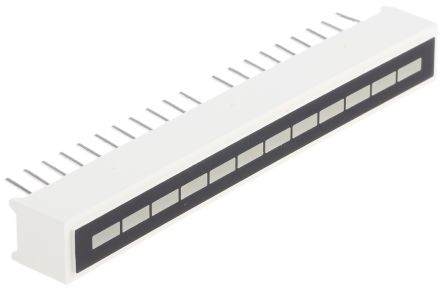 An LED light bar display tends to have its diode(s) set out in a more simple and linear arrangement, consisting of single or multiple sections that light up one at a time in sequence. They’re usually square or rectangular in shape, and are most often used as status or level indicators, for backlighting fixed messages, or to highlight other icons on a display.
An LED light bar display tends to have its diode(s) set out in a more simple and linear arrangement, consisting of single or multiple sections that light up one at a time in sequence. They’re usually square or rectangular in shape, and are most often used as status or level indicators, for backlighting fixed messages, or to highlight other icons on a display.
LED light bar displays are commonly found on devices relating to industries and applications including:
-
-
- medical equipment
- industrial sensors
- home appliances and consumer electronics
- laboratory/production instrumentation
- design and customisation projects
-
LED vs OLED displays
When talking about different types of LED displays - particularly in terms of specs for smartphone, TV and monitor screens - you’ll doubtless have heard the term ‘OLED’ used alongside the more familiar LED display. So what is the difference between OLED and LED?
Well, there are numerous more complicated and (as it were) illuminating answers to that question, but the simplest version is this: standard LED displays tend to rely on backlighting to illuminate pixels, whereas OLED does not.
To add slightly more detail, an LED screen lights pixels (to a greater or lesser extent, according to the image being shown) either from behind or from the side. An OLED display is a newer and much more costly technology that delivers the ability to illuminate or completely switch off each individual pixel. As a result, OLED displays offer deeper blacks and thinner screens by removing the need for backlit arrays.
LED vs LCD displays
There’s often a degree of confusion around questions such as “which is better, LED or LCD?” when it comes to display or screen types. In attempting to clarify exactly what the ‘difference’ is between LCD and LED displays, the key fact to underline is that LED displays are LCD displays - they’re just a specific subset of the broader LCD technology.
As many will already be aware, LCD stands for liquid crystal display. The acronym can be used to describe any panel or display that uses liquid crystal to control where (and how much) light is displayed in each on-screen pixel at any given moment.
Many types of LED displays, particularly in TV screens and computer monitors, use precisely this technology - and so they’re LCD screens by definition. The fact that they also use LEDs to backlight these pixels is what defines LED displays as a subset.
To make matters even more straightforward, be aware that pretty much all LCD displays currently in production are LED variants. The previous common method of lighting LCD screens was using cold cathode fluorescent lamps (CCFLs), and while a few budget panel-makers do still include CCFL options at lower tiers, for most brands that standard has all but been rendered obsolete by the rise of LED technology today.
In short, if you’re looking at purchasing any sort of LCD display made in the last few years, it’s extremely likely to be an LED version (and will almost certainly be referred to as an LED screen specifically, rather than the more generic LCD).
LED display advantages
The advantages of LED displays over other panel and screen types are numerous, depending on what sort of application you’re looking to use them in. Some commonly cited LED display advantages include:
-
-
- They’re highly scalable, and can be used for all screen/panel sizes from large LED displays to very small LED displays.
- LEDs themselves are bright, crisp and eye-catching, for excellent colour reproduction and high contrast visibility in a wide range of scenarios and environments
- LED displays can be configured into very slim and flat panels for sleek aesthetics and great space-saving potential - they can be mounted almost anywhere and look good
- The diodes tend to produce a quality flicker-free image/signal, which is helpful for both general readability and for reduced eye strain
- LED displays draw very little power and are extremely long-lasting, even in continuous use - as such they’re both highly economical and far better for the environment than many alternatives
- They can be manufactured to be completely addressable (100% individually programmable) when fed with the right software, making displays infinitely flexible and customisable
- LED displays are very safe for installers and users alike, as they don’t produce heat and run off far lower voltages than many other display types
-
Potential LED display problems
As with all technologies that deliver so many characteristic advantages, there will inevitably be some occasional disadvantages, compromises and possible display issues with LED screens.
Thankfully, these are relatively low-impact for the most part, and LED displays are generally known for fairly solid dependability. As they ought to be, in fairness - they’re considerably more expensive than many other lighting types, which is one of the main downsides of LED displays at present.
Even so, further examples of LED display problems you might potentially find yourself troubleshooting at some point could include:
-
-
- Gradual colour-shift and potential burn-in over time
- Typically weaker performance in producing pure white light (LEDs tend to display white by mixing other colours at high intensities, which usually results in a tint of some kind)
- Somewhat inconsistent colour and contrast ratios between different brands/configurations of diodes and displays
- Comparatively difficult user maintenance; most basic users would feel less comfortable tinkering with LED arrays than with some other lighting types
-
How to clean LED displays and screens
By far the best approach for cleaning and maintenance of LED displays, panels and screens is to keep it simple and regular: a gentle wiping with a good quality microfibre cloth is all you’ll need for the most part. For more stubborn dust, grease or spills, you can dampen the cloth with a little water, but always try to avoid spraying fluids of any kind directly at an LED screen or display. There’s always a risk of ingress and liquid damage unless the display in question is specifically IP rated against it.
Don’t use cleaning chemicals or waxes with LED displays unless the manufacturer’s notes explicitly state it’s ok to do so, and always be sure to power off and fully unplug displays before cleaning. Although LEDs themselves don’t tend to get hot, you may need to let displays cool in other areas before starting to work on them - and of course, they should be given plenty of time to dry off fully before being plugged back in.
Summary
LED displays of all types are incredibly versatile tools for providing clear, crisp, energy-saving and environmentally conscious readouts of visual information across a wide range of applications, industries and projects.
They’re increasingly widely used both at home and in the workplace, and their ever-growing popularity means that the catalogue of available LED display products is continually growing. The sheer range of LED display panel prices, suppliers and models on the market today can seem intimidating at first, but it’s easily navigated with a basic knowledge of their various configurations and functions.
Click on the links to our more popular brands below:
